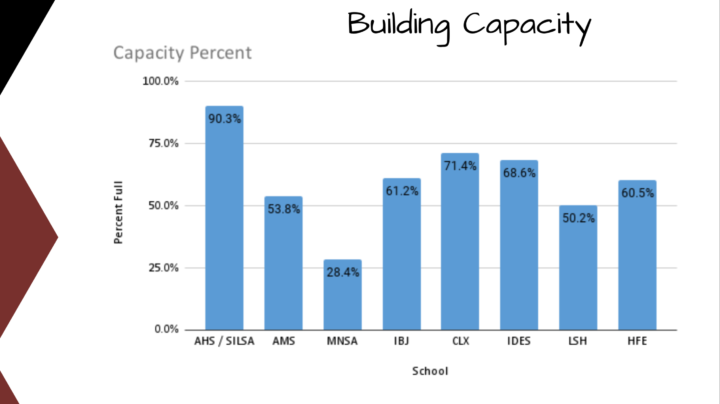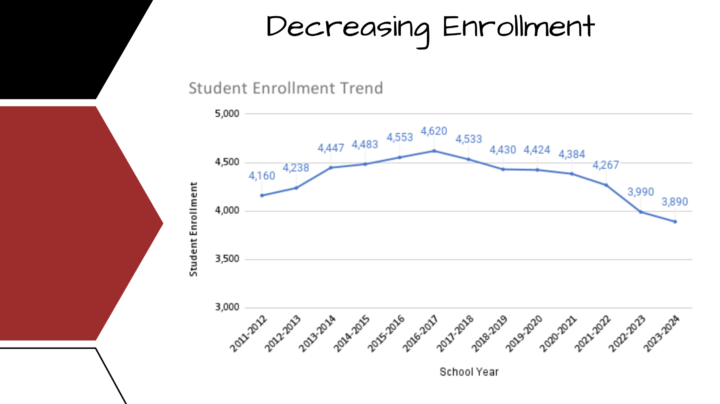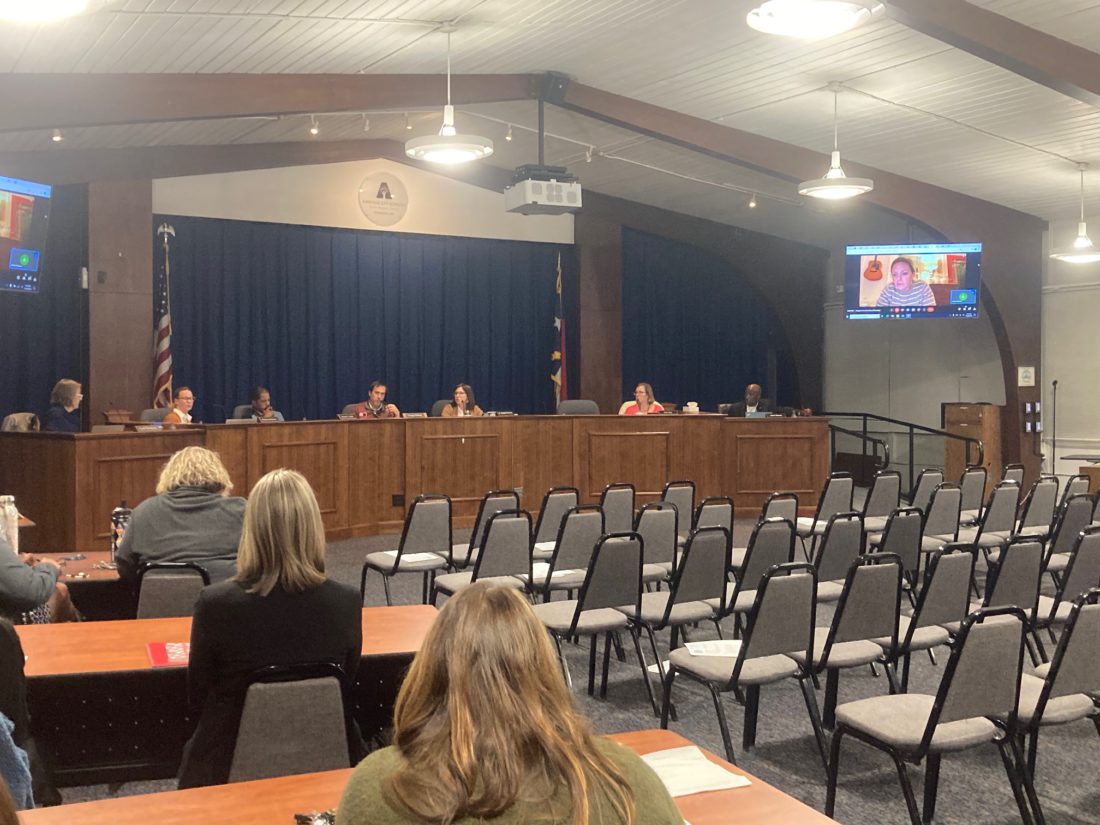As its enrollment declines, leaving some schools half full, Asheville City Schools Superintendent Maggie Fehrman said the district can’t wait to take action to address its financial challenges.
The Asheville City Board of Education voted 6-1 at its Nov. 20 meeting to commission an enrollment and capacity study from California-based Cooperative Strategies without seeking competing bids and started a public conversation about the need to consider consolidating some of its schools.
Liza Kelly was the lone “no” vote on the $28,500 contract to assess the district’s facility capacity and enrollment trends and provide data to help the district make decisions for the future of its schools and facilities.
Fehrman said she worked with Cooperative Strategies when she was interim superintendent in Decatur, Ga., and attested to the quality of the company’s work, saying its enrollment projections have been remarkably accurate up to five years out. Cooperative Strategies also reviewed the 2020 capacity study of ACS and found inaccuracies regarding capacities of buildings, she said.

Kelly said she would rather engage with members of Asheville’s “creative and innovative” community to produce in-house solutions than pay thousands to an outside vendor to begin a conversation that could lead to reducing the number of schools in a district already facing a funding crisis.
“When we start talking about consolidation of schools, that’s only going to further reduce our overall district enrollment. And the last time that discussion was entertained, we ended up with yet another charter school,” she said. “I don’t know if going down this rabbit hole is necessarily the [thing to do] right now.”
Board member Jesse Warren offered some potential solutions.
“Let’s talk about moving Montford North Star Academy to Asheville Middle School. Let’s talk about moving the education and career academy to Montford,” he said. He also wondered which of the district’s elementary schools could become “something even better,” such as a day care facility.
“We have two middle schools that are both vastly under capacity. We have to have the conversation and we can’t wait,” agreed board Vice Chair Amy Ray. “The first thing we have to do, at least from my perspective as one board member, is we have to be honest about what our enrollment numbers are. We have to be honest about the resources we are spending and who we are spending those resources on.”
Montford North Star Academy’s 217 students fill only 28.4% of its facility, by far the lowest in the district, according to a presentation by Fehrman. Asheville Middle School fills about 54% of its building capacity, and the district’s five elementary schools range from roughly 50% to 70% full.
‘Confluence of challenges’
Those numbers, along with the district’s declining enrollment, which is at its lowest since at least 2011-12, and several other factors combine to create a “confluence of challenges,” Fehrman said.

Almost $2.5 million in federal funding from the Elementary and Secondary School Emergency Relief Fund, passed in 2020 to help schools during the pandemic, is set to expire for ACS this year, Fehrman said. Of that, $850,000 went toward staffing needs, including mental health liaisons. The district will need to come up with funding or eliminate positions to make up that gap, she said.
Staff numbers have increased the last two years, partially due to ESSER funding, so the district’s student-to-staff ratio is as low as it’s been since at least 2011-12. That means it costs more per pupil to educate them, Fehrman said. As of 2021-22, ACS had the 18th-highest per-pupil spending of the state’s 116 districts, according to the N.C. Department of Public Instruction.
On top of all that, this year, the state is ending the provision to hold school districts harmless for drops in enrollment during the pandemic, meaning ACS has been funded above its actual enrollment numbers since 2020, Fehrman said. Public school districts are primarily funded by the state based on student enrollment.
Meanwhile, the district’s well-documented achievement gap issues between white and Black students have not improved since it earned a worst-in-the-state designation in 2017.
“We’re throwing lots of resources at academic achievement and addressing our achievement gap,” Fehrman said. “We’re not seeing the results that we would hope to with all those additional resources. So, we’ve got to take a close look at that.”
Board member Sarah Thornburg agreed that there is no time to waste.
“I’m feeling some urgency to start a broader conversation because there’s no doubt there’s hard decisions to be made,” she said. “I don’t want us to just commission a study and sit back for two months because we don’t have time.”
The conversation comes two years after the district controversially closed Asheville Primary School in West Asheville because of its lowest-in-the-district enrollment and about $7 million in facility needs at the time.
Current board Chair George Sieburg introduced the motion to close the school in 2021, a vote he remembers well.
“As one of two people sitting up here who was part of those conversations around the closure of Asheville Primary School, I am desperate to have that work in a different way than it did [two] years ago,” he said. Current board member James Carter was also part of that vote.
Ray said that the difference with leadership now is transparency.
“You will not see this board and you will not see the superintendent say two different things in two successive meetings and not communicate with everyone,” she said.
Consolidation study
Concurrently, the district has created a study team to review potential district consolidation with neighboring Buncombe County Schools, as mandated by the N.C. General Assembly in a recent state budget.
At a work session Nov. 6, Fehrman announced ACS’ team to cooperate with a feasibility study commissioned by Buncombe County. The team includes the assistant superintendent for human resources, the chief financial officer, executive director of equity, facilities director, district principal of the year, district teacher of the year, communications director and a student and parent yet to be named.
Consolidation can be ordered by the General Assembly, the Buncombe County Board of Commissioners or the school districts themselves.
With that looming in the background, board members are wary of the perception of their actions, particularly at the county level.
“County commissioners expect us to right-size our districts now,” Ray said. “They’re not going to wait for us to wait for the entire study.”




No set of bureaucrats will ever lead an evaluation of merging the city and county schools, but that is the obvious solution. We don’t need two sets of administration. Very inefficient.